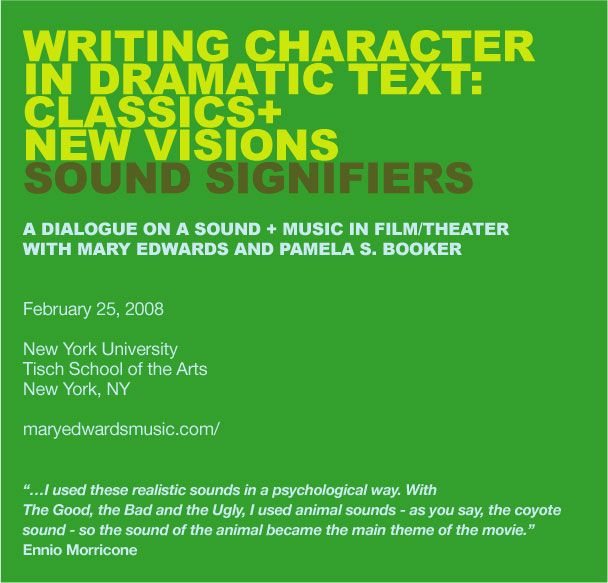|
|

WRITING CHARACTER IN DRAMATIC TEXT: CLASSICS & NEW VISIONS
A dialogue on sound and music in film/theater with Pamela S. Booker and visiting artist Mary Edwards.
.
February 25, 2008
New York University
Tisch School of the Arts
New York, NY
nyu.edu
“…I used these realistic sounds in a psychological way. With The Good, the Bad and the Ugly, I used animal sounds - as you say, the coyote sound - so the sound of the animal became the main theme of the movie.”
–Ennio Morricone
Music and sound subliminally or epically conveys mood and emotion. Mary Edwards will discuss the role of a composer/sound designer and how a score can also trigger location, memory and inform a scene by bridging a film cut or create a theatrical segue.
Is silence a contradiction or companion to sound? How much does the audience rely on the auditory "space" constructed for them? What is the difference between diagetic and non-diagetic music? These and other questions are explored in conjunction with readings and a dialogue on components of sound signifiers.
Pamela S. Booker is an interdisciplinary writer, educator and photographer/visual conceptualist who works in the traditions of artist and scholar. Her practice is informed by the multiple/hybrid applications and urgencies of critical analysis, social responsibility, race, gender, sexual identities and media. Herwritings have been published and performed in the United States and internationally. They cross genres and disciplines in the creation of performance and dramatic texts, essays, fiction, poetry and multimedia driven projects. Her forthcoming work, Sacred/Pretty/Smart, explores the relationship between creativity and sacred practices; and her recent publication, Dust: murmurs and a play, (Evolutionary Girls 2008) is a collection of essays and the performance text of her play Dust, that examines global terror, love and healing during and in the aftermath of 9-11.
Mary Edwards is a composer whose projects range from recordings evocative of cinematic soundtracks to scores and sound installations both about and utilizing the properties of architecture and the natural environment that enhance spatial experience, foster deep listening, and create cinema for the ear. Her recording, Everyday Until Tomorrow, is a sound and space trilogy inspired by interrelated spaces––airports, woodlands, and wombs––which are, at once, perceived as both vast and intimate. Each shares the conflict of desire and uncertainty that seems to simultaneously haunt these types of spaces. Each space draws on the relationship we have with temporality, where the anticipation of travel or movement often overshadows the destination.
|

